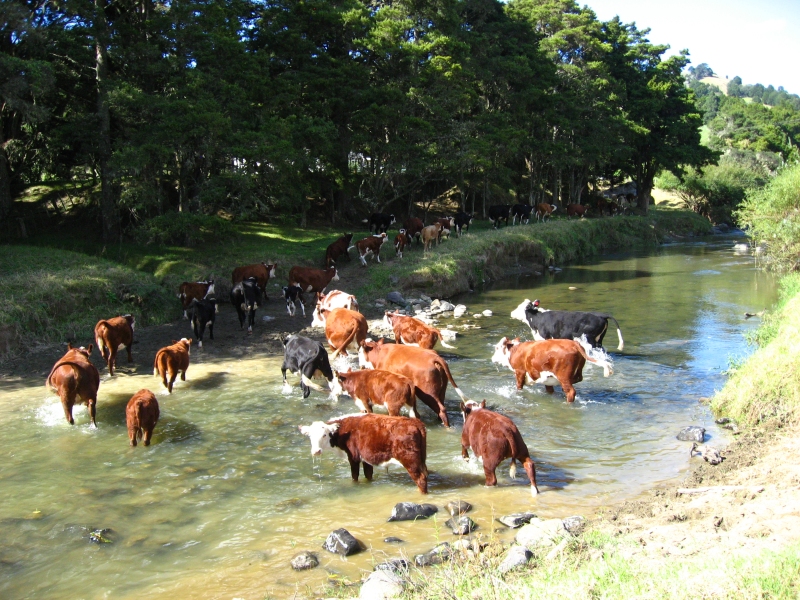Since European settlement there have been many changes in land use in New Zealand, with large forested areas having been cleared for human habitation and agriculture.
Prior to colonisation, 80% of New Zealand's land area was forested. Recent estimates suggest that 50% of our land area is now pasture/cropland, 5–10% is exotic forest (Radiata pine) and 10–15% is native forest. Land use change can affect waterways in a number of ways by changing the temperature, light, water quality and structure of the system.
In terms of habitat, longfins have been classed as being more generalist than shortfins and because of this, habitat changes may affect the two species differently. Land use changes such as the transformation of land into exotic grassland or forest can have a variety of influences on freshwater eels.
Much of the habitat that was formerly available to eels has been lost through practices like the wetland drainage and river channelling. For example, it is estimated that 90% of the lower Waikato wetlands that were present at the time of European settlement have since been drained.
Researchers have found larger and faster growing eels in pasture settings compared to native and exotic forest, and settings dominated by willow or tussock.
Pasture sites are likely to be associated with higher nutrient levels, increased light, and therefore increased productivity which could explain the larger size of eels.
The lower water temperatures associated with forested areas in comparison to more open pastoral areas may also partially explain lower eel growth. Shortfin eels generally occur more often at pastoral sites in comparison to indigenous forest.
Eels seem to be relatively unaffected by logging and are known to be comparatively tolerant of silty substrates, which can result from the destabilisation of ground during felling.
However, sedimentation may reduce the availability of food to tuna by clogging up instream substrates where organisms such as invertebrates and kōura live.
About 35% of the total longfin eel habitat in New Zealand has been affected by hydroelectric power production development.
It is estimated that the habitats affected could sustain about 3,600 tonnes of longfins, with most being large females.
References and further reading
Beentjes, M.P., Boubée, J.A.T., Jellyman, D.J., Graynoth, E. (2005). Non-fishing mortality of freshwater eels (Anguilla spp.). New Zealand Fisheries Assessment Report 2005/34 . Ministry of Fisheries, Wellington. 38 p. http://fs.fish.govt.nz/Doc/17219/2005%20FARs/05_34_FAR.pdf.ashx
Broad, T.L. Townsend, C.R., Closs, G.P., Jellyman, D.J. (2002). Riparian land use and accessibility to fishers influence size class composition and habitat use by longfin eels in a New Zealand river. Journal of Fish Biology 61: 1489-1503. http://onlinelibrary.wiley.com/doi/10.1111/j.1095-8649.2002.tb02492.x/abstract
Larned, S. (2003). New Zealand Streams and Rivers. Alpha 117. Royal Society of New Zealand. 8 p. http://www.royalsociety.org.nz/teaching-learning/resources/alpha/117/
Chisnall, B.L. (1987). Juvenile Eel Biology in the Backwaters of the Waikato River. Master of Science Thesis, University of Waikato, New Zealand. 152 p.
Chisnall, B.L. (1989). Age, growth, and condition of freshwater eels (Anguilla spp.) in backwaters of the lower Waikato River, New Zealand. New Zealand Journal of Marine and Freshwater Research 23: 459-465.
Chisnall, B.L., Hicks, B.J. (1993). Age and growth of longfinned eels (Anguilla dieffenbachii) in pastoral and forested streams in the Waikato River basin, and in two hydro-electric lakes in the North Island, New Zealand. New Zealand Journal of Marine and Freshwater Research 27: 317-332. http://www.royalsociety.org.nz/publications/journals/nzjm/1993/030/
Graynoth, E. (1979). Effect of logging on stream environments and faunas in Nelson. New Zealand Journal of Marine and Freshwater Research 13: 79-109. http://www.royalsociety.org.nz/publications/journals/nzjm/1979/009/
Graynoth, E., Niven, K. (2004). Habitat for female longfinned eels in the West Coast and Southland, New Zealand. Science for Conservation 238. Department of Conservation, Wellington. 333 p. http://www.doc.govt.nz/upload/documents/science-and-technical/SfC238.pdf
Graynoth, E., Francis, R. I.C.C., Jellyman, D.J. (2008). Factors influencing juvenile eel (Anguilla spp.) survival in lowland New Zealand streams. New Zealand Journal of Marine and Freshwater Research 42: 153-172. http://www.tandfonline.com/doi/abs/10.1080/00288330809509945
Hanchet, S.M. (1990). Effect of land use on the distribution and abundance of native fish in tributaries of the Waikato River in the Hakarimata Range, North Island, New Zealand. New Zealand Journal of Marine and Freshwater Research 24(2): 159-171. http://www.royalsociety.org.nz/publications/journals/nzjm/1990/015/
Hicks, B.J., McCaughan, H.M.C. (1997). Distribution of fish and crayfish, and eel production, in streams in forest and pasture in the Waikato Region, New Zealand. New Zealand Journal of Marine and Freshwater Research 31: 635-650. http://www.royalsociety.org.nz/publications/journals/nzjm/1997/055/
Jowett, I.G., Richardson, J. (1990). Microhabitat preferences of benthic invertebrates in a New Zealand river and the development of instream flow habitat models for Deleatidium spp. New Zealand Journal of Marine and Freshwater Research 24: 19-30. http://www.royalsociety.org.nz/publications/journals/nzjm/1990/003/
Potangaroa, J. (2010). Tuna kuwharuwharu, the longfin eel. An educational resource: facts, threats and how to help. 26 p.
Taylor, M.J. (1988). Features of freshwater fish habitat in South Westland, and the effect of forestry practices. Freshwater Fisheries Report 97. New Zealand Ministry of Agriculture and Fisheries. 89 p.
Useful links
- Department of Conservation: http://www.doc.govt.nz/
- Kaitaiki Tools: http://www.niwa.co.nz/our-science/freshwater/tools/kaitiaki_tools/impacts
- New Zealand Legislation: Freshwater Fisheries Regulations 1983 http://www.legislation.govt.nz/regulation/public/1983/0277/latest/DLM92492.html



